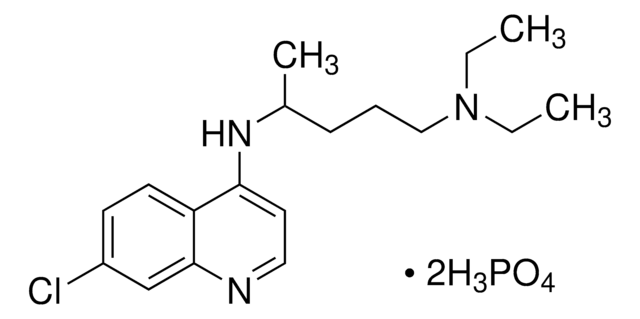C6628
Chloroquin -diphosphat (Salz)
98.5-101.0% (EP), powder or crystals, anti-malarial drug
Synonym(e):
N4-(7-Chlorchinolin-4-yl)-N1,N1-diethylpentan-1,4-diamin-diphosphat, N4-(7-Chlor-4-chinolinyl)-N1,N1-diethyl-1,4-pentandiamin -diphosphat (Salz)
About This Item
Empfohlene Produkte
product name
Chloroquin -diphosphat (Salz), powder or crystals, 98.5-101.0% (EP)
Qualitätsniveau
Assay
98.5-101.0% (EP)
Form
powder or crystals
mp (Schmelzpunkt)
192-198 °C
Wirkungsspektrum von Antibiotika
parasites
Wirkungsweise
enzyme | inhibits
SMILES String
OP(O)(O)=O.OP(O)(O)=O.CCN(CC)CCCC(C)Nc1ccnc2cc(Cl)ccc12
InChI
1S/C18H26ClN3.2H3O4P/c1-4-22(5-2)12-6-7-14(3)21-17-10-11-20-18-13-15(19)8-9-16(17)18;2*1-5(2,3)4/h8-11,13-14H,4-7,12H2,1-3H3,(H,20,21);2*(H3,1,2,3,4)
InChIKey
QKICWELGRMTQCR-UHFFFAOYSA-N
Angaben zum Gen
human ... ABCC1(4363)
Suchen Sie nach ähnlichen Produkten? Aufrufen Leitfaden zum Produktvergleich
Verwandte Kategorien
Allgemeine Beschreibung
Anwendung
Chloroquin-Diphosphatsalz wurde in folgenden Anwendungen eingesetzt:
- in In-vitro-Assays gegen Plasmodien
- in Transfektions- und Infektionsassays
- für die Hemmung der Autophagie
- für die Differenzierung von induzierten pluripotenten Stammzellen (iPS) zu Kardiomyozyten
- bei der Durchflussbehandlung von infiziertem Blut
Biochem./physiol. Wirkung
Leistungsmerkmale und Vorteile
Anwendung
Signalwort
Warning
H-Sätze
Gefahreneinstufungen
Acute Tox. 4 Oral
Lagerklassenschlüssel
11 - Combustible Solids
WGK
WGK 3
Flammpunkt (°F)
Not applicable
Flammpunkt (°C)
Not applicable
Persönliche Schutzausrüstung
dust mask type N95 (US), Eyeshields, Gloves
Analysenzertifikate (COA)
Suchen Sie nach Analysenzertifikate (COA), indem Sie die Lot-/Chargennummer des Produkts eingeben. Lot- und Chargennummern sind auf dem Produktetikett hinter den Wörtern ‘Lot’ oder ‘Batch’ (Lot oder Charge) zu finden.
Besitzen Sie dieses Produkt bereits?
In der Dokumentenbibliothek finden Sie die Dokumentation zu den Produkten, die Sie kürzlich erworben haben.
Kunden haben sich ebenfalls angesehen
Artikel
We presents an article on Autophagy in Cancer Promotes Therapeutic Resistance
Protein-based drug transporters are expressed in Sf9 cells. Understanding the specific mechanisms of tumor cell transporters is an essential aspect of chemotherapeutic drug design.
Discover Bioactive Small Molecules for ADME/Tox
Chromatograms
application for HPLCUnser Team von Wissenschaftlern verfügt über Erfahrung in allen Forschungsbereichen einschließlich Life Science, Materialwissenschaften, chemischer Synthese, Chromatographie, Analytik und vielen mehr..
Setzen Sie sich mit dem technischen Dienst in Verbindung.











